“Global Automotive Active Safety System Market to reach a market value of USD 38.3 Billion by 2031 growing at a CAGR of 15.6%”
The Global Automotive Active Safety System Market size is expected to reach $38.3 billion by 2031, rising at a market growth of 15.6% CAGR during the forecast period.
ACC offers significant convenience by automatically adjusting the vehicle’s speed to maintain a safe distance from the car ahead, reducing driver fatigue, especially on long highway drives. This makes it a highly sought-after feature among consumers. Adaptive Cruise Control (ACC) greatly improves road safety by reducing the risk of rear-end collisions, among the most frequent types of accidents. As safety becomes a top priority for consumers and regulators, the demand for ACC systems has surged. Thus, the adaptive cruise control segment garnered 22% revenue share in the automotive active safety system market 2023.
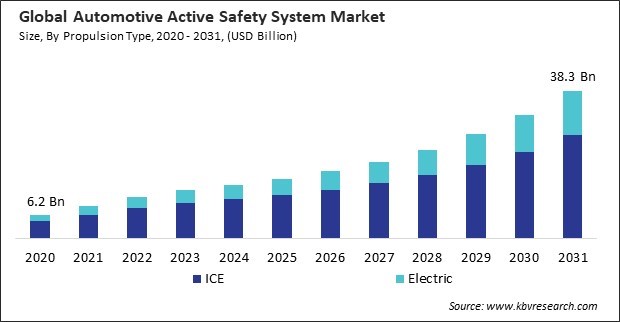
The major strategies followed by the market participants are Partnerships as the key developmental strategy to keep pace with the changing demands of end users. For instance, In January, 2024, NXP Semiconductors N.V. announced a partnership with Damon Motors, an urban mobility solutions provider, to integrate NXP's advanced automotive technology into Damon motor's electric motorcycles, enhancing safety, connectivity, and performance. This partnership leverages NXP's robust automotive ICs, embedded security solutions, and technical expertise, enabling Damon to accelerate development cycles and deliver secure, over-the-air updates for smarter, safer riding. Additionally, In 2024, August, Intel Corporation came into partnership with Karma Automotive, a vehicle manufacturer, to develop Software Defined Vehicle Architecture (SDVA) for future vehicles. This partnership would revolutionize vehicle architecture by enhancing efficiency, performance, and flexibility.
Based on the Analysis presented in the KBV Cardinal matrix; NXP Semiconductors N.V., Infineon Technologies AG, Volvo Group and Robert Bosch GmbH are the forerunners in the Automotive Active Safety System Market. Companies such as Intel Corporation, Renesas Electronics Corporation and Denso Corporation are some of the key innovators in Automotive Active Safety System Market. In August, 2024, Intel Corporation came into partnership with Karma Automotive, a vehicle manufacturer, to develop Software Defined Vehicle Architecture (SDVA) for future vehicles. This partnership would revolutionize vehicle architecture by enhancing efficiency, performance, and flexibility.
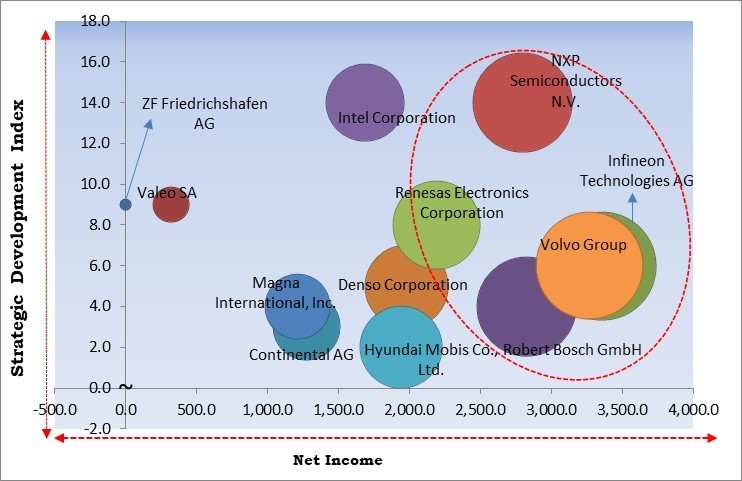
Active safety systems are designed to mitigate the impact of human error, which is a leading cause of accidents. By implementing technologies that assist with driving tasks, the industry aims to reduce the risk associated with human fallibility.
Additionally, technologies like pedestrian automatic emergency braking (PAEB) are designed to address the risks associated with pedestrians and cyclists, contributing to safer urban mobility and reducing the likelihood of severe accidents.
Automakers face pressure on profit margins when incorporating costly safety technologies into their vehicles. To maintain profitability, manufacturers might limit the inclusion of these features to higher-end models, reducing their availability in more affordable segments. Thus, the high costs of advanced safety technologies impede the market's growth.
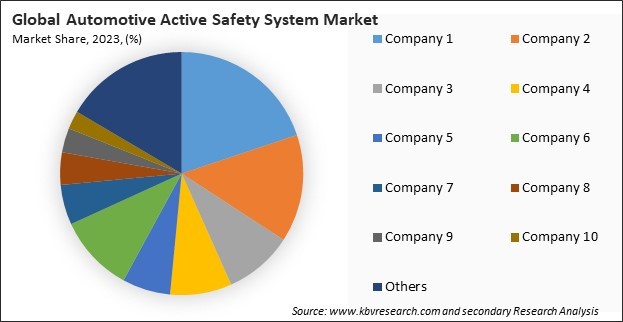
The leading players in the market are competing with diverse innovative offerings to remain competitive in the market. The above illustration shows the percentage of revenue shared by some of the leading companies in the market. The leading players of the market are adopting various strategies in order to cater demand coming from the different industries. The key developmental strategies in the market are Partnerships & Collaborations.
Based on type, the market is divided into tire-pressure monitoring system, lane departure warning, adaptive cruise control, night vision system, driver monitoring, antilock braking system, blind spot detection, and others. The antilock braking system segment attained 20% revenue share in the automotive active safety system market in 2023. With a global emphasis on reducing road accidents and fatalities, ABS is recognized as a critical technology that helps prevent collisions caused by uncontrolled braking.
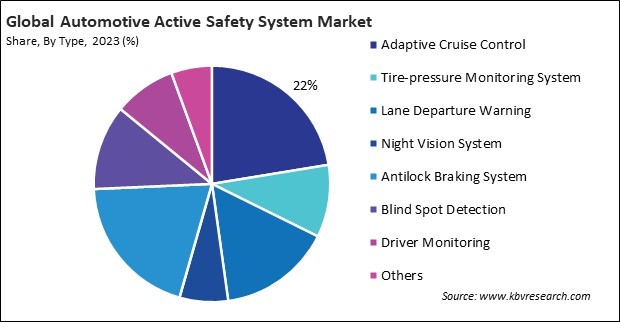
On the basis of sensor type, the market is segmented into camera sensor, radar sensor, and lidar sensor. The radar sensor segment recorded 48% revenue share in the automotive active safety system market in 2023. Radar sensors are highly effective in detecting objects regardless of weather conditions, like rain, snow, or fog.
By vehicle type, the market is classified into passenger cars, light commercial vehicles, heavy commercial vehicles, and buses & coaches. The light commercial vehicles segment procured 19% revenue share in the automotive active safety system market in 2023. Active safety systems provide valuable assistance to drivers by reducing fatigue and improving comfort during long drives.
Based on propulsion type, the market is bifurcated into ICE and electric. In 2023, the electric segment procured 27% revenue share in the market. The growing adoption of electric vehicles globally is a key driver of the segment’s expansion.
Free Valuable Insights: Global Automotive Active Safety System Market size to reach USD 38.3 Billion by 2031
Region-wise, the market is analyzed across North America, Europe, Asia Pacific, and LAMEA. In 2023, the Asia Pacific region generated 29% revenue share in the market. The Asia-Pacific region is experiencing rapid urbanization and an increase in vehicle ownership.
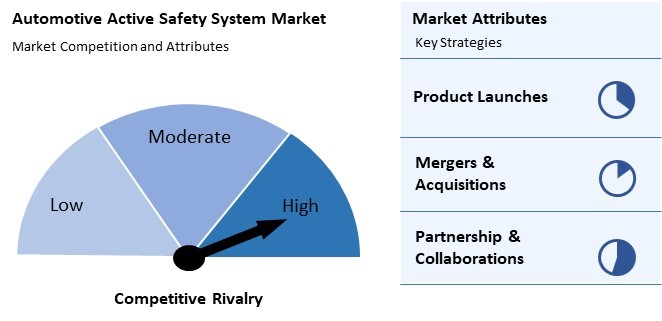
The automotive active safety system market is highly competitive, with numerous global players vying for market share. Key attributes driving competition include technological innovation, such as advanced driver assistance systems (ADAS), and integration of AI and machine learning for enhanced safety. Leading companies focus on developing cutting-edge sensors, cameras, and radar systems to improve vehicle safety. Market competition is intensified by rapid technological advancements, regulatory pressures, and the demand for cost-effective, reliable safety solutions.
| Report Attribute | Details |
|---|---|
| Market size value in 2023 | USD 12.6 Billion |
| Market size forecast in 2031 | USD 38.3 Billion |
| Base Year | 2023 |
| Historical Period | 2020 to 2022 |
| Forecast Period | 2024 to 2031 |
| Revenue Growth Rate | CAGR of 15.6% from 2024 to 2031 |
| Number of Pages | 377 |
| Number of Tables | 498 |
| Report coverage | Market Trends, Revenue Estimation and Forecast, Segmentation Analysis, Regional and Country Breakdown, Competitive Landscape, Market Share Analysis, Porter’s 5 Forces Analysis, Company Profiling, Companies Strategic Developments, SWOT Analysis, Winning Imperatives |
| Segments covered | Propulsion Type, Sensor Type, Vehicle Type, Type, Region |
| Country scope |
|
| Companies Included | Robert Bosch GmbH, Continental AG, ZF Friedrichshafen AG, Valeo SA, Magna International, Inc., Denso Corporation, Intel Corporation, NXP Semiconductors N.V., Infineon Technologies AG, Renesas Electronics Corporation, Teledyne FLIR LLC (Teledyne Technologies Incorporated), Hyundai Mobis Co., Ltd. (Hyundai Motor), Forvia SE, Knorr-Bremse AG and Volvo Group |
By Propulsion Type
By Sensor Type
By Vehicle Type
By Type
By Geography
This Market size is expected to reach $38.3 billion by 2031.
Growing focus on improving urban mobility are driving the Market in coming years, however, High costs of advanced safety technologies restraints the growth of the Market.
Robert Bosch GmbH, Continental AG, ZF Friedrichshafen AG, Valeo SA, Magna International, Inc., Denso Corporation, Intel Corporation, NXP Semiconductors N.V., Infineon Technologies AG, Renesas Electronics Corporation, Teledyne FLIR LLC (Teledyne Technologies Incorporated), Hyundai Mobis Co., Ltd. (Hyundai Motor), Forvia SE, Knorr-Bremse AG and Volvo Group
The expected CAGR of this Market is 15.6% from 2024 to 2031.
The ICE segment is leading the Market by Propulsion Type in 2023; thereby, achieving a market value of $26.8 billion by 2031.
The North America region dominated the Market by Region in 2023, and would continue to be a dominant market till 2031; thereby, achieving a market value of $12.9 billion by 2031.
Our team of dedicated experts can provide you with attractive expansion opportunities for your business.

 Drivers
Drivers
 Restraints
Restraints
 Opportunities
Opportunities
 Challenges
Challenges
